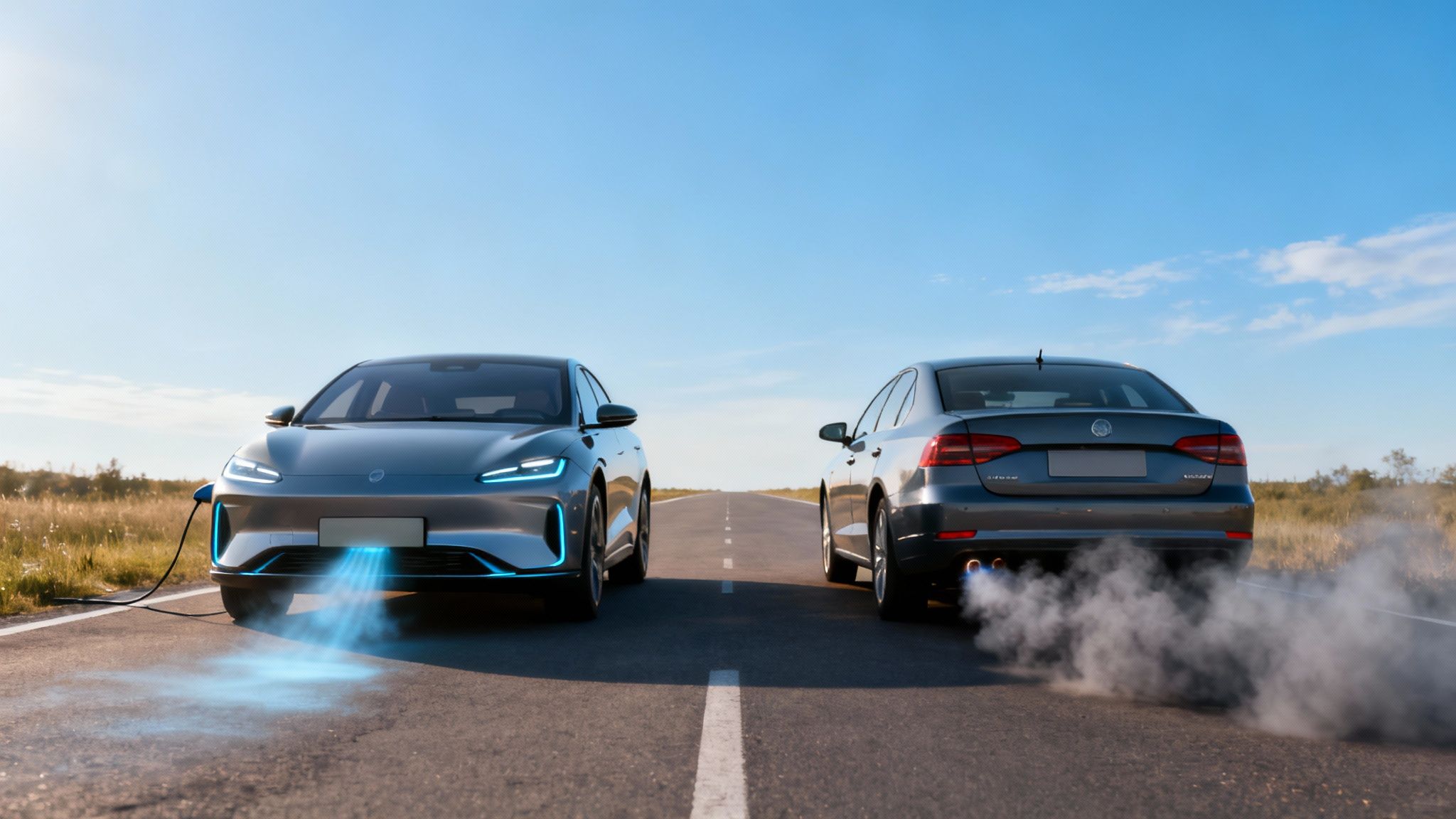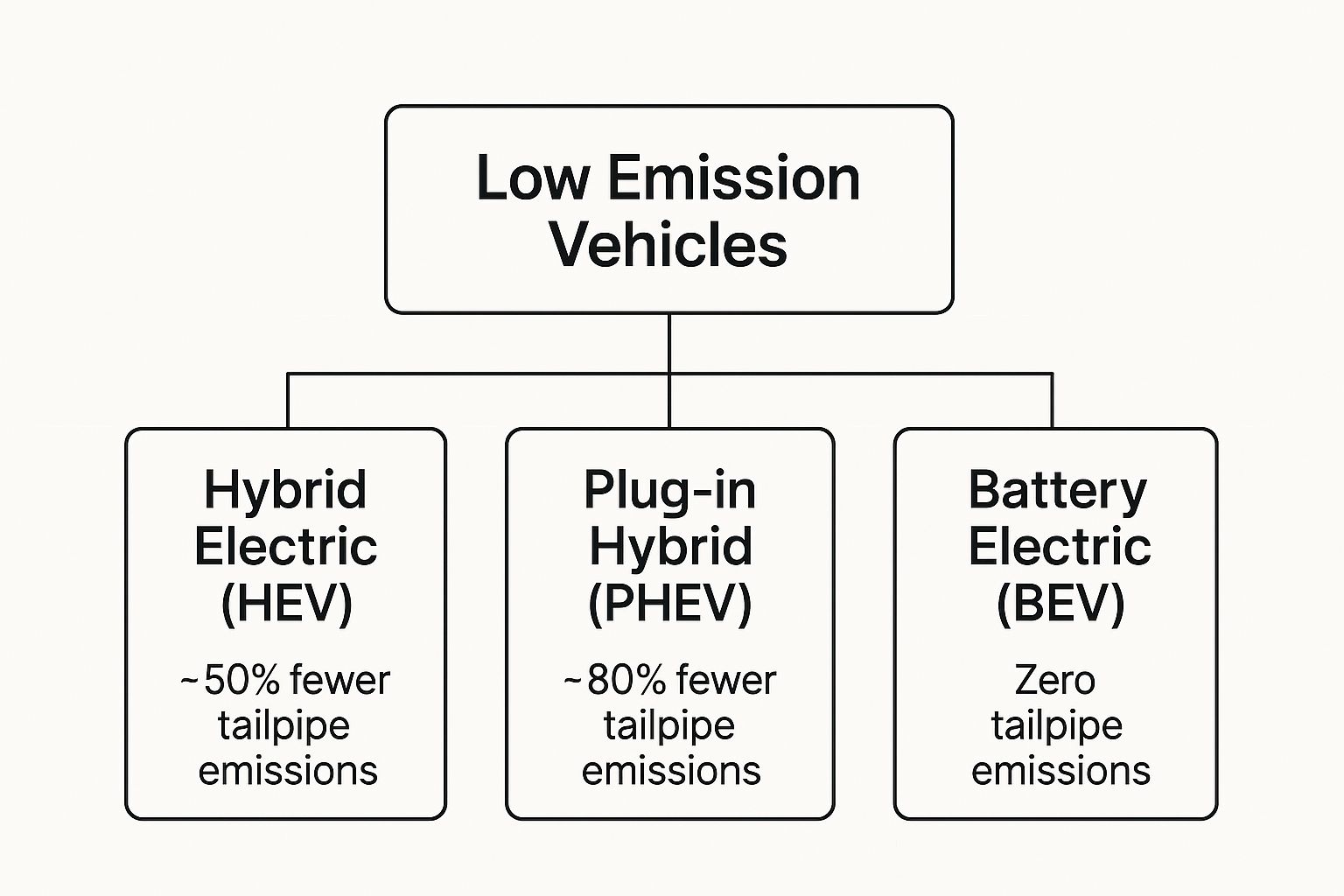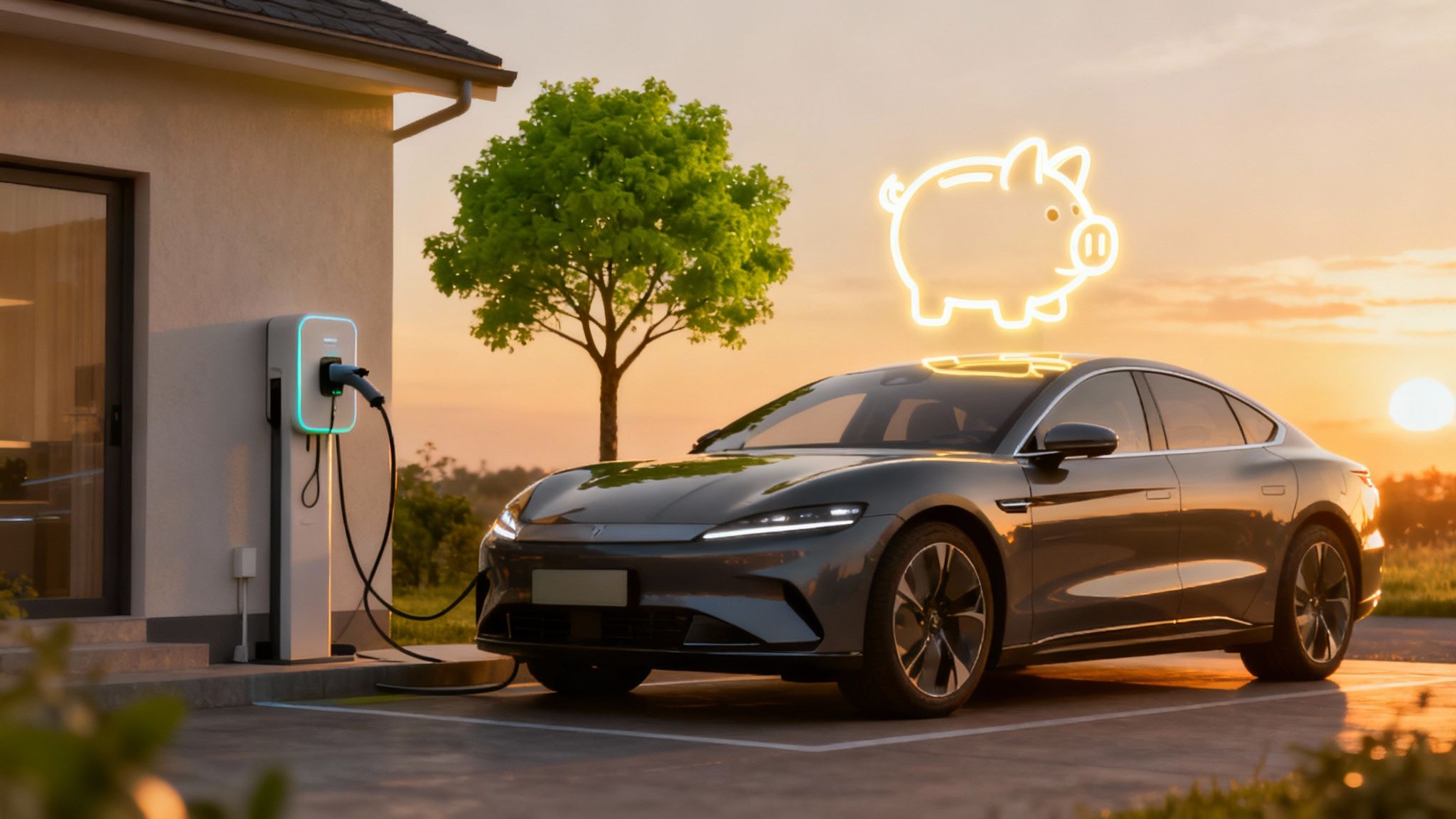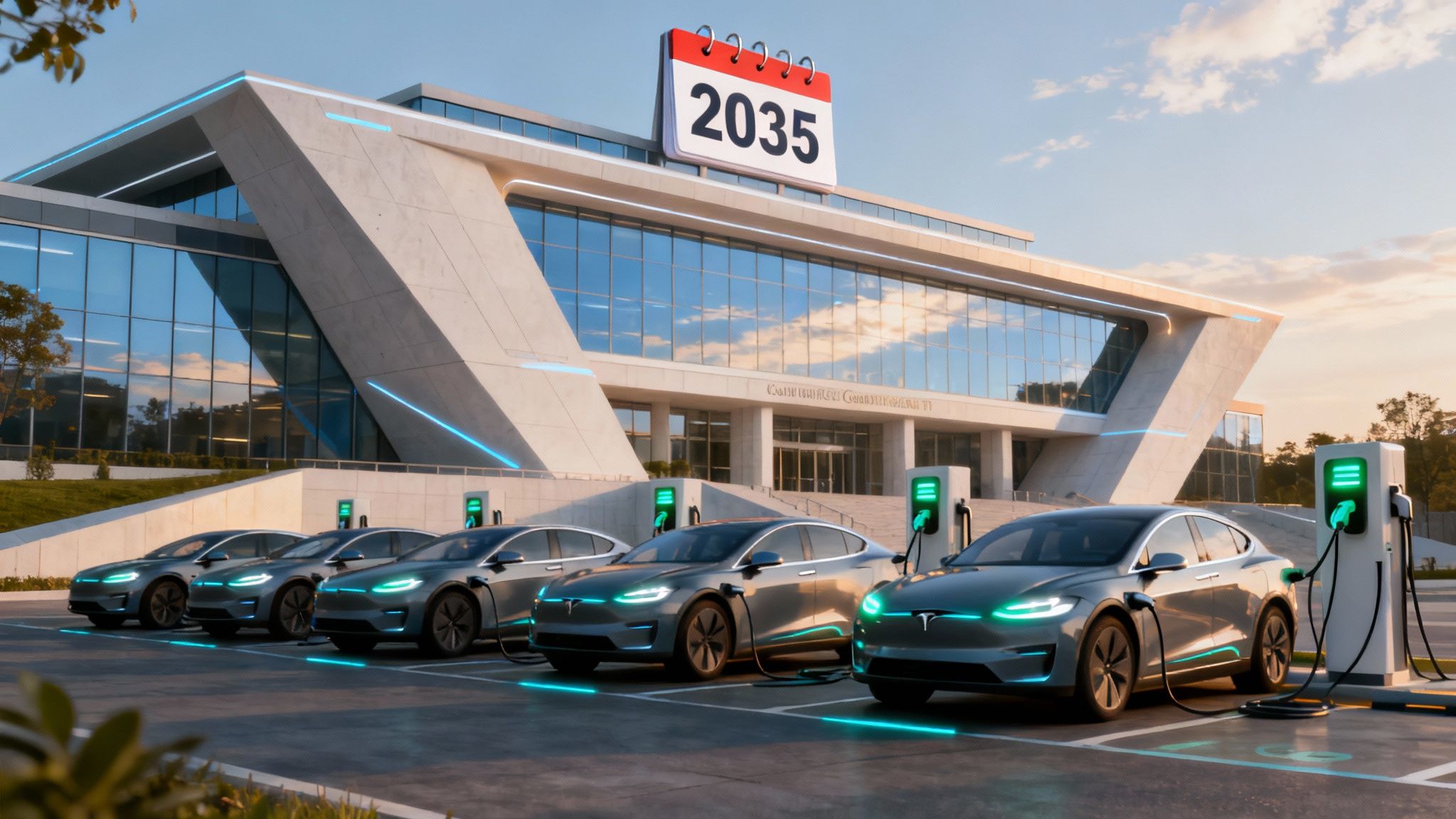A low emission vehicle (LEV) is, simply put, any car built to release far fewer harmful pollutants than your standard gas-guzzler.
Think of it this way: a traditional car's exhaust is like a smoky, inefficient campfire. An LEV, on the other hand, is more like a clean-burning gas stove—it gets the job done with a dramatically smaller environmental footprint. This simple but powerful idea is completely changing our roads and the cars we drive.
What Exactly Makes a Vehicle "Low Emission"?
At its heart, the term low emission vehicle is a broad umbrella covering several types of cars. They all share one common goal: to slash their carbon footprint.

These vehicles achieve this by relying, either partially or fully, on power sources other than the classic internal combustion engine. This isn't just an environmental fad; it's a fundamental evolution in automotive engineering.
The numbers tell the story. The global market for low emission vehicles was valued at USD 208.52 billion in 2024. It’s expected to explode to USD 688.33 billion by 2032, which is a massive compound annual growth rate of 16.1%. If you're curious, you can explore more about this market growth to see just how fast this shift is happening.
To help clarify, this table breaks down the essential attributes that define a low emission vehicle, offering a quick snapshot of what sets them apart from conventional cars.
Core Characteristics of a Low Emission Vehicle
| Attribute | Description |
|---|---|
| Reduced Tailpipe Emissions | The primary goal. LEVs emit significantly fewer pollutants like carbon dioxide (CO2), nitrogen oxides (NOx), and particulate matter compared to gasoline-only cars. |
| Alternative Powertrain | They use technology beyond just a standard internal combustion engine. This includes electric motors, batteries, and sometimes more advanced fuel systems. |
| Improved Fuel Economy | By using electricity or other alternative fuels, LEVs drastically reduce reliance on gasoline, leading to better overall mileage and lower running costs for the owner. |
| Regulatory Compliance | These vehicles are specifically designed to meet or exceed strict government emissions standards, such as those set by the EPA in the U.S. or Euro standards in Europe. |
In short, an LEV is all about using smarter technology to move people around more cleanly and efficiently.
Meet the Key Players in the LEV Family
To really get a handle on what low emission vehicles are, it helps to know the main types you'll see on the road. Each takes a different path to cutting emissions, offering a unique set of benefits.
-
Hybrid Electric Vehicles (HEVs): These are the original hybrids. They cleverly combine a gasoline engine with an electric motor. The real magic is that the battery recharges itself through braking—a process called regenerative braking—so you never have to plug it in.
-
Plug-in Hybrid Electric Vehicles (PHEVs): Think of these as a step up from a standard hybrid. PHEVs have a much larger battery that you can charge by plugging into an outlet. This lets you drive a decent distance on pure electric power before the gas engine ever needs to kick in.
-
Battery Electric Vehicles (BEVs): Often just called EVs, these are the top of the line when it comes to clean driving. They run 100% on electricity and have no tailpipe at all, meaning they produce zero local emissions.
The core idea behind LEVs is progress, not perfection. While not every LEV is a zero-emission vehicle, each one represents a huge leap away from our dependence on fossil fuels and a step toward a cleaner, more sustainable future for transportation.
Exploring the Different Types of Low Emission Vehicles
Not all low emission vehicles are built the same. It's a broad term that covers a whole spectrum of automotive tech, and each type takes a different route to shrinking its environmental footprint. Getting a handle on these differences is the first step to seeing just how far we've come.
Think of it like different kinds of rechargeable gadgets. Some recharge themselves as you use them, others need to be plugged in, and a few run on a completely different kind of power pack. Low emission vehicles follow a similar logic, falling into a few main categories based on how they mix gasoline and electric power—or whether they use gas at all.
Hybrid Electric Vehicles (HEVs): The Self-Chargers
Hybrid Electric Vehicles, or HEVs, were the originals—the pioneers that brought low-emission driving to the mainstream. They’re clever machines, pairing a standard gasoline engine with an electric motor and a small battery. From the driver's seat, it feels just like a regular car, but under the hood, it's constantly working to be more efficient.
The key feature of an HEV is that you never have to plug it in. The battery recharges on the go through a process called regenerative braking, which captures energy that’s normally wasted when you slow down. That stored electricity then helps out at low speeds or gives the gas engine a boost, cutting down on fuel use and emissions in a big way.
Plug-in Hybrid Electric Vehicles (PHEVs): The Best of Both Worlds
Take a step up from the standard hybrid and you get the Plug-in Hybrid, or PHEV. These vehicles really dial things up with a much larger battery that you can charge from an outlet, just like your phone.
That bigger battery gives a PHEV a decent all-electric range—often more than enough for the average daily commute. You can handle your daily errands on pure, zero-emission electricity. When you need to go further, the gas engine kicks in seamlessly, so there's absolutely no range anxiety. It’s the perfect compromise: an EV for around town and a traditional car for long road trips, all rolled into one.
This infographic breaks down how these different vehicle types compare when it comes to cutting emissions.

As you can see, every step up the electric ladder brings a massive drop in what comes out of the tailpipe, leading us to the cleanest option of all.
Battery Electric Vehicles (BEVs): The Zero-Emission Champions
Finally, we have Battery Electric Vehicles, better known as BEVs or simply EVs. These are the gold standard for low emission vehicles because they have zero tailpipe emissions. Period. They run entirely on electricity stored in a large battery pack, with one or more electric motors doing all the work.
A BEV gets rid of the internal combustion engine completely. That means no more oil changes, no exhaust systems, and no trips to the gas station. What you get instead is a quiet, smooth, and surprisingly powerful ride, all powered by an electric grid that's getting greener every year.
There's also a cool subset of this category designed specifically for local travel. If you're curious, you can learn all about what a Neighborhood Electric Vehicle is in our detailed guide. These smaller BEVs are a perfect fit for planned communities, campuses, and resorts.
We should also mention Hydrogen Fuel Cell Vehicles (FCEVs). Though less common, they're another type of true zero-emission vehicle. FCEVs use hydrogen gas to generate their own electricity onboard, and their only byproduct is water vapor. The refueling infrastructure is still in its early days, but they represent another exciting path toward a future of clean transportation.
The Unstoppable Rise of Electric Vehicles
https://www.youtube.com/embed/rkxMdmipYqM
The shift toward electric vehicles isn't just a quiet trend—it's a full-blown automotive revolution. This powerful movement is being propelled by a perfect storm of government action, incredible leaps in technology, and a real change in what drivers actually want. We are witnessing a seismic shift away from gasoline-powered cars.
A huge part of this growth comes from direct government support. Incentives like tax credits and rebates have made EVs far more affordable for the average person, turning what was once a luxury item into a practical choice for many households. These policies send a crystal-clear message: the future of driving is electric.
Pushing Past Old Barriers
For years, a couple of major roadblocks held back EV adoption: the high upfront cost and the dreaded "range anxiety"—that nagging fear your battery will die in the middle of a trip. But thanks to relentless innovation in battery technology, those concerns are quickly becoming a thing of the past.
Battery costs have plummeted over the last decade, which directly brings down the sticker price of new electric cars. At the same time, their energy density has shot through the roof. This simply means modern EVs can go hundreds of miles on one charge, making them more than capable for daily commutes and even long-haul road trips.
The market has responded with explosive growth. In 2024, global electric vehicle sales hit around 17 million units, capturing an impressive 20% of all new car sales worldwide. Looking ahead to 2025, that number is expected to jump past 20 million, meaning one out of every four new cars sold will be electric.
A New Era of Infrastructure and Mindset
Beyond the policies and the tech, we're seeing a fundamental change in how people think about cars. More and more drivers are putting a premium on sustainability and performance, two areas where EVs are clear winners. The silent, instant torque and zero tailpipe emissions offer a driving experience that traditional cars just can't match.
This isn't a gradual change; it's a decisive one. Automakers and entire countries are now setting firm deadlines to phase out internal combustion engine vehicles for good, locking in the transition to electric power.
Of course, this rapid growth needs a solid support system. As more EVs hit the road, building out a comprehensive electric vehicle charging infrastructure is absolutely essential to keep them moving. Supporting this growth also means creating a secure environment with things like Electric Vehicle security bollards for charging stations. The rise of EVs isn't just about the cars—it's about creating the entire ecosystem they need to thrive.
What Are the Real-World Benefits of Driving an LEV?
Let’s cut through the noise of environmental policy and technical specs. When you get right down to it, switching to a low emission vehicle (LEV) makes a real, noticeable difference in your day-to-day life. These aren't just abstract ideas; they're practical advantages you'll feel in your bank account, see in your neighborhood, and experience every time you get behind the wheel. The growing shift toward LEVs isn't just a trend—it's driven by a powerful mix of smart savings, genuine environmental care, and a seriously upgraded driving experience.

Financial Wins and Lower Upkeep
One of the first things you'll notice is just how much less you spend to keep your car moving. Swapping unpredictable gas station prices for the lower, more stable cost of electricity is a game-changer. For many EV drivers, this means saving hundreds, sometimes thousands, of dollars every year. That's real money that can go toward a family vacation, a home project, or simply peace of mind.
The savings go well beyond fuel. Fully electric vehicles are mechanically simpler than their gas-powered cousins, with far fewer moving parts. Think about it—you can cross these common maintenance headaches off your list for good:
- Oil changes
- Spark plug replacements
- Exhaust system fixes
- Timing belt services
This elegant simplicity means fewer trips to the mechanic and less money spent on upkeep. When you look at the total cost of ownership over several years, the financial argument for an LEV becomes incredibly compelling.
A Cleaner Environment for Everyone
Driving a low emission vehicle is one of the most powerful and direct actions you can take for a healthier planet. Each LEV on the road means fewer harmful pollutants are pumped into the air we all breathe. It’s that simple.
This is about more than just tackling long-term climate change. It’s about improving the quality of life right here, right now. Cleaner air means fewer respiratory problems and a healthier, safer environment for our kids and communities.
Making the change is a personal choice that has a public benefit. If you’re interested in doing even more, you can learn how to reduce vehicle emissions through other simple habits. Every step, big or small, adds up to a much larger positive impact.
An Unmistakably Better Drive
Perhaps the most pleasant surprise for first-time LEV drivers is just how good the car feels to drive. Electric motors provide instant torque, which translates to smooth, silent, and surprisingly quick acceleration.
There's no engine rumble, no jerky gear shifts, and no vibrations—just a quiet, responsive ride that transforms a stressful city commute into a calm, controlled experience. This blend of immediate power and near-total silence makes driving an LEV feel both futuristic and genuinely fun.
How Zero Emission Mandates Are Shaping Our Future
While "low emission" is a fantastic step forward, the real destination is "zero emission." This isn't just a hopeful dream; it's a future being built right now by powerful government regulations. These rules are designed to push us away from fossil fuels, and fast. They aren't gentle nudges—they're legally binding mandates that are completely overhauling the auto industry as we know it.

It’s helpful to understand how these terms relate. Think of it this way: all Zero Emission Vehicles (ZEVs) are low emission vehicles, but not all low emission vehicles are ZEVs. A ZEV is the pinnacle, producing absolutely zero pollutants from its tailpipe.
A ZEV mandate is essentially a deadline. It's a government saying, "By this date, all new cars sold must produce zero emissions." This forces automakers to stop developing gasoline engines and pour all their resources into electric and hydrogen technology.
This decisive action is creating some serious momentum. The market for ZEVs—which covers both battery electric vehicles (BEVs) and hydrogen fuel cell vehicles (FCEVs)—is set to explode from USD 321,501 million in 2025 to over USD 3,191,454 million by 2035. That's a staggering annual growth rate of 25.8%. If you want to dig deeper, you can discover more insights about the ZEV market and see just how massive this shift is.
The Global Push for Zero Emissions
This push isn't just happening in one or two places. It's part of a coordinated global effort to hit some ambitious climate targets and build a truly sustainable transportation future.
Governments worldwide are setting hard deadlines to stop the sale of new internal combustion engine (ICE) vehicles. These policies remove the guesswork for both carmakers and customers, creating a clear and predictable road ahead. The result? Faster adoption of cleaner cars.
Here are a few of the front-runners leading this charge:
- California: A long-time leader, the state's Advanced Clean Cars II rule requires that 100% of new passenger vehicles sold must be zero-emission by 2035.
- European Union: The EU has agreed to what is effectively a ban on the sale of new petrol and diesel cars starting in 2035, steering the entire continent toward electric mobility.
- United Kingdom: The UK is even more ambitious, setting a 2030 deadline to end the sale of new gas and diesel cars.
These rules have a huge ripple effect. Since automakers build cars for a global audience, a major mandate in a place like California or the EU ends up shaping the kinds of vehicles that are sold everywhere else.
So, what does this all mean for you? It means your next car purchase is part of a much bigger story—an international strategy in motion. Choosing to drive a low or zero-emission vehicle isn't just a personal decision anymore. It's you, doing your part in a worldwide plan to ensure we have a cleaner planet for generations to come.
Your Guide to the Low Emission Future
We’ve covered a lot of ground together, from figuring out what a "low emission vehicle" actually is to diving into the differences between hybrids and fully electric cars. It's clear that the benefits aren't just about saving money at the pump; they're about taking a real, collective step toward a healthier planet for all of us.
The main takeaway here is simple: cleaner cars are no longer some far-off idea. They're here, right now, and becoming a bigger part of our daily lives.
This massive shift isn't happening by accident. It's being pushed forward by powerful market trends, smart government policies, and a real, growing demand from people who want more sustainable ways to get around. Think of this guide as your foundational roadmap—the knowledge you need to confidently navigate this change.
Of course, a truly low-emission future involves more than just our cars. It's about powering our lives with clean energy, and that often starts at home with things like solar panels, which are encouraged by incentives like the federal solar tax credit.
The road ahead is undoubtedly becoming more electric. With the insights you've gained here, you're now equipped with a map to understand what this means for you, your community, and the world. You’re ready for the road ahead.
Common Questions About Low Emission Vehicles
Jumping into the world of low emission vehicles can feel like learning a new language. You've got questions, and that's a good thing. Let's clear up some of the most common ones we hear from people just like you.
Aren't Low Emission Vehicles a Lot More Expensive?
It’s true that the sticker price on some LEVs, especially fully electric cars, can look a bit higher than a standard gas-powered equivalent. But that initial number is only a small part of the picture.
Think of it this way: the upfront cost is starting to come down as battery tech gets better and production ramps up. On top of that, many government incentives, like tax credits and rebates, can knock thousands off that initial price. Once you add in the massive savings from never visiting a gas station again and the minimal maintenance required, many LEVs actually end up being the cheaper option over their lifetime.
How Long Does It Actually Take to Charge an EV?
This is a great question, and the answer is: it depends! Just like filling up a gas tank can be quick or slow depending on the pump, charging an EV varies based on the charger's power and your vehicle's battery.
Here’s a simple breakdown:
- Level 1 Charging: This is just plugging into a regular wall outlet at home. It’s slow, often taking 24 hours or more for a full charge, so it's best for topping off your battery overnight.
- Level 2 Charging: The sweet spot. This is what you'll find in most home chargers and public stations. It can give you a full charge in about 4 to 8 hours—perfect for an overnight fill-up.
- DC Fast Charging: These are the superchargers you see along highways. They are incredibly powerful and can give you hundreds of miles of range in just 20 to 30 minutes. They’re the game-changer for road trips.
Do These Cars Really Help the Environment?
Yes, they make a huge difference. While every car has a manufacturing footprint, an LEV's lifetime impact is drastically lower than a conventional vehicle's. A battery-electric vehicle has zero tailpipe emissions. That means cleaner air right here in our neighborhoods and cities.
The real magic is moving the source of emissions. Instead of millions of individual tailpipes pumping out fumes, the demand shifts to a few centralized power plants. As our grid gets cleaner with more solar and wind, the EVs charged by it get cleaner too.
This is a fundamental shift that's absolutely critical for hitting climate targets and just making our communities healthier places to live.
What About "Range Anxiety"? Is That Still a Thing?
Ah, range anxiety—the fear of your battery dying in the middle of nowhere. A few years ago, this was a legitimate worry. Today? Not so much. Modern electric vehicles routinely offer ranges of 250-350 miles or even more on a single charge.
Public charging networks are also popping up everywhere, so finding a spot to plug in is getting easier by the day. For your average daily driving—commuting to work, running errands, picking up the kids—you’ll have more than enough power from a simple overnight charge at home.
Ready to see what a quiet, powerful, and eco-friendly ride feels like? The Solana EV lineup features premium, street-legal electric vehicles built for both performance and style. Whether it's for your neighborhood, resort, or just for you, your perfect ride is waiting. Explore our models now at SolanaEV.com.
